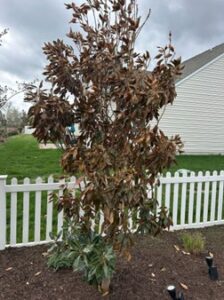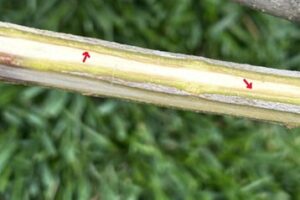Verticillium Wilt
Few pests or diseases can bring down what looks like a healthy tree in under a week—but Verticillium Wilt is one of them. Thankfully, it’s not very common and primarily affects Southern magnolias.
While many tree species are technically susceptible, we documented only about two dozen cases in our first ten years of operation. Of those, all but one involved Southern magnolias—the lone exception being a sugar maple.
Most affected trees had one thing in common: prolonged stress. Inadequate irrigation and poor soil fertility often weaken trees’ natural defenses. Southern magnolias, in particular, are vulnerable due to their soft, shallow roots, which thrive best in evenly moist, well-draining, organic-rich soils. Plus, as their name suggests, they’re not built to handle extended periods of freezing temperatures.
The fungus responsible for Verticillium Wilt lives in the soil. It invades weakened roots and moves upward, clogging the tree’s vascular system as it spreads. The telltale signs? Rapid browning and drooping of leaves on entire branches, along with dark olive-green to black streaks in the sapwood of small branches (¼”–1” in diameter). Symptoms may take years to appear after the initial infection.
Unfortunately, there’s no cure. The only way to manage the disease is by removing infected trees and replanting with non-susceptible species—ideally, anything other than Southern magnolia or maple. Prevention is your best defense. That means proper fertilization, consistent watering, pest management, and overall good tree care to keep stress levels low and defenses high.


